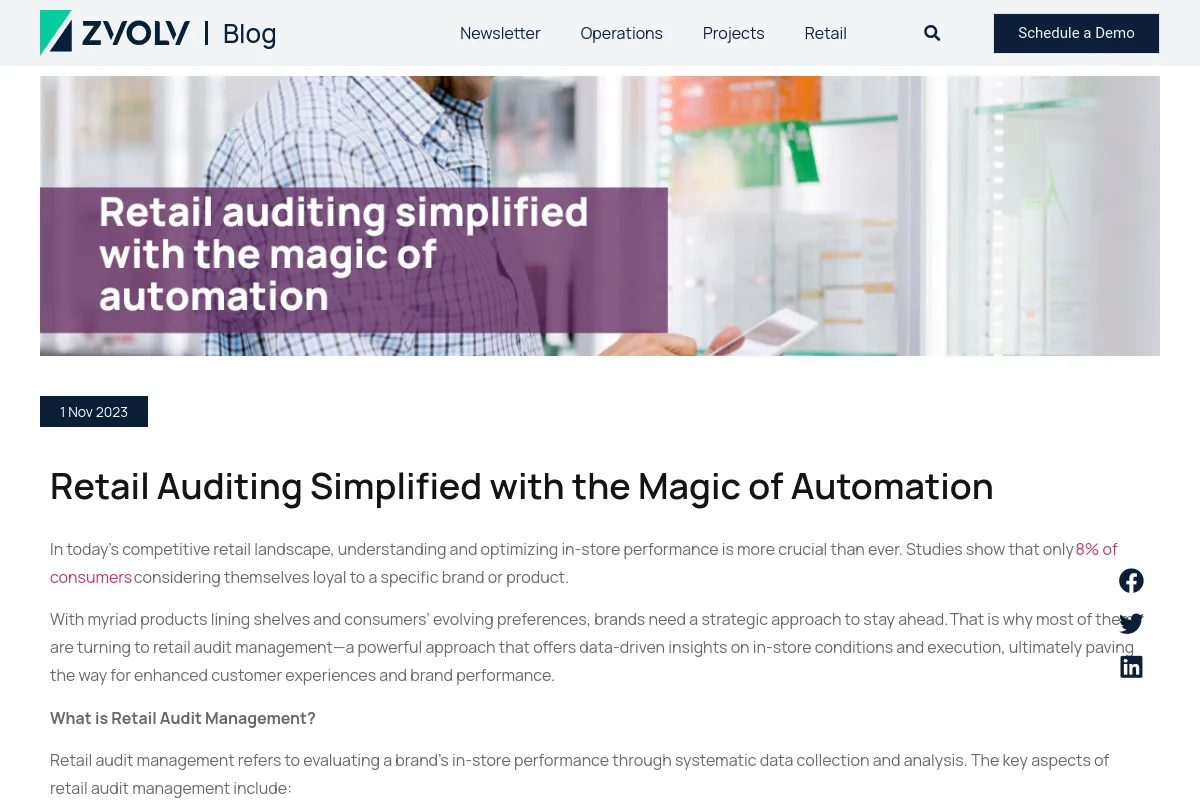Retail Auditing Simplified with the Magic of Automation
Blog: Zvolv Blog
In today’s competitive retail landscape, understanding and optimizing in-store performance is more crucial than ever. Studies show that only 8% of consumers considering themselves loyal to a specific brand or product.
With myriad products lining shelves and consumers’ evolving preferences, brands need a strategic approach to stay ahead. That is why most of them are turning to retail audit management—a powerful approach that offers data-driven insights on in-store conditions and execution, ultimately paving the way for enhanced customer experiences and brand performance.
What is Retail Audit Management?
Retail audit management refers to evaluating a brand’s in-store performance through systematic data collection and analysis. The key aspects of retail audit management include:
- Conducting audits of retail stores where a brand’s products are sold to gather data on product availability, pricing, promotions, display compliance, inventory levels, competitor activity, etc.
- Leveraging methodical approaches like location and demographic audits, inventory audits, etc., to capture all the relevant data.
- Analysing the audit data to identify issues and opportunities for improvement in areas like product placement, inventory management, branding, pricing, promotions, etc.
- Identifying root causes driving audit failures and taking corrective actions.
- Tracking audit performance over time to measure progress.
- Automating parts of the audit management process using retail audit solution to increase efficiency, speed, compliance, and coverage.
The core goal of retail audit management is to use data-driven insights about in-store conditions, operations, and execution to make improvements that will positively impact the customer experience and drive stronger retail performance for a brand. It provides the foundation for making retail stores more profitable for brands.
Types of Retail Audits
Explore different audits to understand your business operations better:
Retail Operations Audit
Focus: Assessing store operational processes for compliance with company standards.
Example: Examining a store’s return procedure.
Timing: Regular intervals or around specific store events or sales.
Advertising Audit
Focus: Evaluating in-store marketing initiatives.
Questions: Are products displayed properly? Is signage effective?
Timing: Scheduled routinely or aligned with product promotions or store events.
Gathering Customer Service Audit Data
Focus: Gauging a store’s customer service quality.
Tip: Surprise or anonymous audits yield a genuine snapshot of staff behavior.
Compilation of Loss Prevention Audit Data
Focus: Minimizing waste, theft, and risk.
Purpose: Reinforces commitment to curbing revenue losses.
Timing: Typically at set times annually.
Health and Safety Audit
Focus: Ensuring adherence to product handling guidelines and regulatory compliance.
Goal: Identify workplace hazards through periodic reviews.
Essential Components of a Retail Audit
- Location Data: Especially in newer markets, ground-level information is crucial. Gathering location-specific details ensures you’re on point with product distribution and compliance.
- Demographic Data: Get a comprehensive view of your product’s surroundings with insights like neighborhood attributes, store conditions, and even street views.
- In-Store Data: The heart of the audit – it gives insights into product positioning, shelf share, inventory status, merchandising quality, and more.
- Competitive Analysis: Understanding competitors’ in-store performance offers a benchmark to gauge your brand.
Why are Retail Audits Crucial?
- Drive Sales and Market Share: Retail audit data allows for swift adjustments in store arrangements based on direct consumer feedback. Moreover, understanding competition helps predict market trends and facilitates more informed decisions.
- Ensure Compliance: Despite meticulous planning, non-compliance can result in significant sales loss. Audits ensure adherence to product placements, pricing, and promotions agreements.
- Elevate Customer Experience: A stellar in-store experience can set your brand apart. You can gauge a shopper’s journey through retail audits – from product findability to interactions with store staff.
Zvolv centralizes audit scheduling, tracking, analysis and reporting in one system. Automated workflows for new store openings/closings and product launches speed up processes. AI-enabled inventory optimization reduces waste while supplier integrations improve demand forecasting. Overall, Zvolv optimizes audits for efficiency, consistency, and actionability and:
- Encourages higher standards for order matching by incorporating more data points than just the standard three-way matching of Purchase Request (PR), Purchase Order (PO), and Invoice. It includes additional parameters like receipt of goods (GRN), payment confirmations, financial reconciliations, and vendor feedback.
- Automates the ordering process for recurrent procurement items, choosing the best vendors based on pre-defined business rules.
- Enhances organizational spend alignment by offering superior allocation and tracking of budget lines backed by centralized data analytics.
Optimizing retail performance goes beyond mere observation. It requires a systematic, data-driven approach that can highlight strengths and improvement areas.
Advanced tools like Zvolv’s retail audit management system combine advanced features, AI-driven capabilities, and process enhancements to drive efficiency, cost savings, risk mitigation, and stronger supplier relationships for organizations. It helps brands navigate the retail terrain more effectively, making informed decisions that bolster sales, customer experience, and overall brand consistency.
